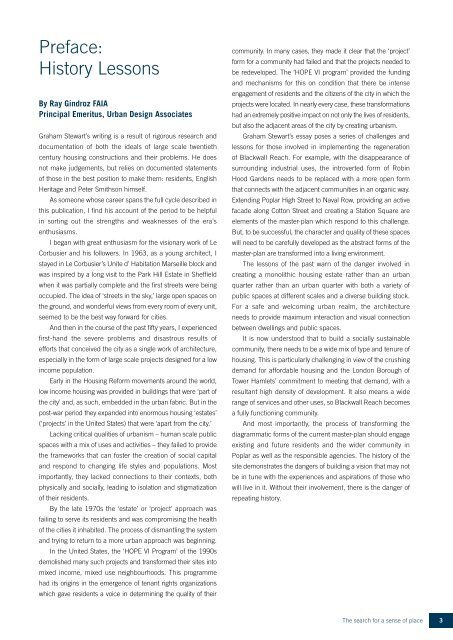Robin Hood Gardens Blackwall Reach - Wild Search
Robin Hood Gardens Blackwall Reach - Wild Search
Robin Hood Gardens Blackwall Reach - Wild Search
Create successful ePaper yourself
Turn your PDF publications into a flip-book with our unique Google optimized e-Paper software.
Preface:History LessonsBy Ray Gindroz FAIAPrincipal Emeritus, Urban Design AssociatesGraham Stewart’s writing is a result of rigorous research anddocumentation of both the ideals of large scale twentiethcentury housing constructions and their problems. He doesnot make judgements, but relies on documented statementsof those in the best position to make them: residents, EnglishHeritage and Peter Smithson himself.As someone whose career spans the full cycle described inthis publication, I find his account of the period to be helpfulin sorting out the strengths and weaknesses of the era’senthusiasms.I began with great enthusiasm for the visionary work of LeCorbusier and his followers. In 1963, as a young architect, Istayed in Le Corbusier’s Unite d’ Habitation Marseille block andwas inspired by a long visit to the Park Hill Estate in Sheffieldwhen it was partially complete and the first streets were beingoccupied. The idea of ‘streets in the sky,’ large open spaces onthe ground, and wonderful views from every room of every unit,seemed to be the best way forward for cities.And then in the course of the past fifty years, I experiencedfirst-hand the severe problems and disastrous results ofefforts that conceived the city as a single work of architecture,especially in the form of large scale projects designed for a lowincome population.Early in the Housing Reform movements around the world,low income housing was provided in buildings that were ‘part ofthe city’ and, as such, embedded in the urban fabric. But in thepost-war period they expanded into enormous housing ‘estates’(‘projects’ in the United States) that were ‘apart from the city.’Lacking critical qualities of urbanism – human scale publicspaces with a mix of uses and activities – they failed to providethe frameworks that can foster the creation of social capitaland respond to changing life styles and populations. Mostimportantly, they lacked connections to their contexts, bothphysically and socially, leading to isolation and stigmatizationof their residents.By the late 1970s the ‘estate’ or ‘project’ approach wasfailing to serve its residents and was compromising the healthof the cities it inhabited. The process of dismantling the systemand trying to return to a more urban approach was beginning.In the United States, the ‘HOPE VI Program’ of the 1990sdemolished many such projects and transformed their sites intomixed income, mixed use neighbourhoods. This programmehad its origins in the emergence of tenant rights organizationswhich gave residents a voice in determining the quality of theircommunity. In many cases, they made it clear that the ‘project’form for a community had failed and that the projects needed tobe redeveloped. The ‘HOPE VI program’ provided the fundingand mechanisms for this on condition that there be intenseengagement of residents and the citizens of the city in which theprojects were located. In nearly every case, these transformationshad an extremely positive impact on not only the lives of residents,but also the adjacent areas of the city by creating urbanism.Graham Stewart’s essay poses a series of challenges andlessons for those involved in implementing the regenerationof <strong>Blackwall</strong> <strong>Reach</strong>. For example, with the disappearance ofsurrounding industrial uses, the introverted form of <strong>Robin</strong><strong>Hood</strong> <strong>Gardens</strong> needs to be replaced with a more open formthat connects with the adjacent communities in an organic way.Extending Poplar High Street to Naval Row, providing an activefacade along Cotton Street and creating a Station Square areelements of the master-plan which respond to this challenge.But, to be successful, the character and quality of these spaceswill need to be carefully developed as the abstract forms of themaster-plan are transformed into a living environment.The lessons of the past warn of the danger involved increating a monolithic housing estate rather than an urbanquarter rather than an urban quarter with both a variety ofpublic spaces at different scales and a diverse building stock.For a safe and welcoming urban realm, the architectureneeds to provide maximum interaction and visual connectionbetween dwellings and public spaces.It is now understood that to build a socially sustainablecommunity, there needs to be a wide mix of type and tenure ofhousing. This is particularly challenging in view of the crushingdemand for affordable housing and the London Borough ofTower Hamlets’ commitment to meeting that demand, with aresultant high density of development. It also means a widerange of services and other uses, so <strong>Blackwall</strong> <strong>Reach</strong> becomesa fully functioning community.And most importantly, the process of transforming thediagrammatic forms of the current master-plan should engageexisting and future residents and the wider community inPoplar as well as the responsible agencies. The history of thesite demonstrates the dangers of building a vision that may notbe in tune with the experiences and aspirations of those whowill live in it. Without their involvement, there is the danger ofrepeating history.The search for a sense of place 3


